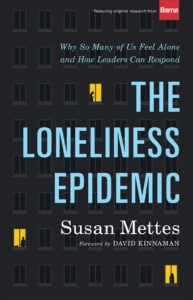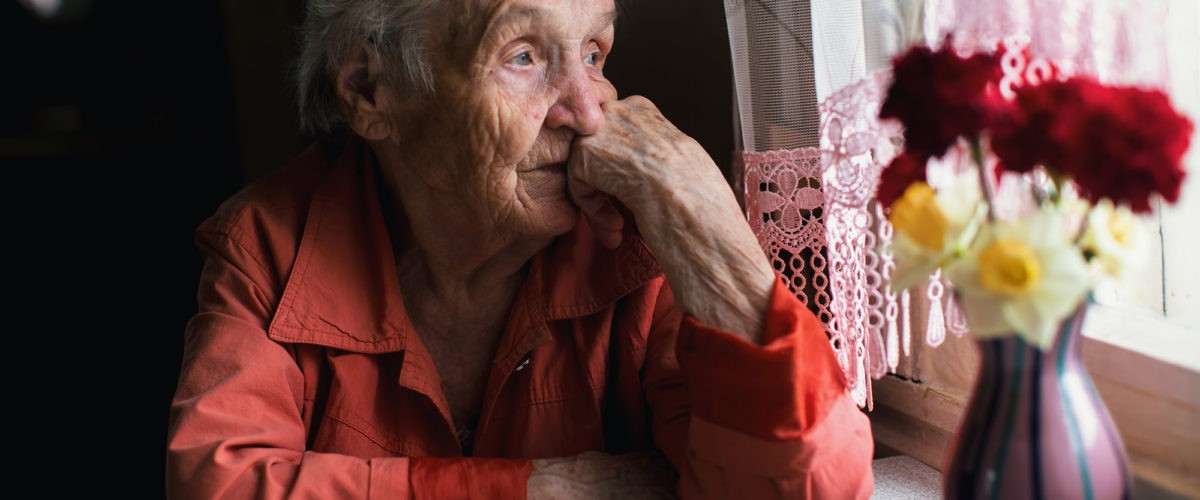In 2020, the topic of loneliness was everywhere. Concern for seniors in retirement homes, for singles stuck in efficiency apartments, and for other groups of Americans rose as it became clear that the disease could overwhelm hospitals and interfere with care. Keeping the most vulnerable people safe became a priority, and that meant keeping our lives to ourselves.
What Americans of every stripe experienced combines several factors that contribute to loneliness: rejection, discrimination and the suspicion that one’s neighbors wouldn’t help in an emergency. Put another way, they show a breakdown in belongingness, the warm network of mutually trusting and important relationships.

Susan Mettes
Although loneliness was a hot topic in 2020, it is by no means a new feature of American life. I started writing before the COVID-19 pandemic. The topic seemed timely, and when the U.S. surgeon general declared loneliness a national epidemic, I already had been seeing loneliness lurking in the Barna data.
In addition to articles expressing concern about the rise of loneliness, there are the answering voices saying it has often been like this. In the book In Search of Intimacy: Surprising Conclusions from a Nationwide Survey on Loneliness and What to Do about It, Carin Rubenstein and Phillip Shaver say, “Some experts have begun referring to the new ‘nationwide epidemic of loneliness.’ But even back in the 1940s, journalist John Gunther, traveling all over the country to research his book on America, called loneliness ‘one of the supreme American problems.’” In Search of Intimacy was published in 1982, and it has the smell and the curlicue script lettering to prove it.
A history of loneliness
Rates of loneliness are higher today than they were in the 1980s, when they already were high enough to alarm cultural commentators, but we should note that loneliness is a chronic problem. Especially when we expect quick fixes, chronic problems can seem like something fresh going wrong. Yet in the 1850s, the 1940s, the 1980s, and the 2020s, cultural commentators sounded the alarm about American loneliness. Here’s hoping that in the 2030s they start discussing its decline.
We know very little about loneliness in the United States. We know what is happening now, of course, but we don’t have much data from the past. We don’t know what loneliness was like for America’s slaves. We don’t know what loneliness was like for American pioneers. We don’t know what loneliness was like for our troops in World War II. We don’t know what loneliness was like for the first Chinese immigrants to California. We don’t know what loneliness was like for Native Americans before Europeans ever arrived.
The statistical studies that allow us to compare loneliness in America between the last few decades and today didn’t exist for other times when we might have expected a good deal of loneliness. But expected and reported loneliness are very different. One of the main findings of my book is that groups of people often disprove our hypotheses about their levels of loneliness. If we had survey data on groups throughout American history, we might be surprised. They may have given us insight into how to help our society now.
“Loneliness is perennial. Loneliness is pretty much universal. And yet loneliness is urgent.”
What we experience is a blip in history — and yet we have reason to believe that we could connect with generations going back to the beginning, when Adam couldn’t find a suitable companion. We believe that loneliness could help us connect even across cultures.
Loneliness is something people have experienced, as far as we can tell, in all times and places. Loneliness is perennial. Loneliness is pretty much universal. And yet loneliness is urgent.
America’s loneliness problem
That said, loneliness seems to have an upside. Think of much of American music, from B.B. King to Billie Eilish. Would it really be a good thing to erase the loneliness behind their music? Would we prefer that Fyodor Dostoevsky or Charlie Chaplin hadn’t understood disappointment and isolation?
Along these lines, some question whether we should try to solve loneliness. They propose that it has a place in human flourishing. I cautiously agree. Occasional loneliness is a foil to satisfying relationships. Thirsting for them every now and then might make us better at investing in intimacy.
However, chronic loneliness is defined by deficiency and distress, and it has destructive effects on human life and creativity. Chronic loneliness is rooted in unquenchable insecurity. Such loneliness pushes people toward death, senility, heart trouble and poor responses to disease. These are not good things; we shouldn’t encourage each other to just live with them throughout a shortened life.
“Chronic loneliness is rooted in unquenchable insecurity.”
To be sure, our bodies and minds need unexpected challenges and even painful ones. Many Christians would say we need stress for spiritual development. But we also need rest from stress for physical healing, for problem solving, and — yes — for spiritual development. That means we need relief from loneliness, at least for periods of time.
America has an intimacy problem
For our loneliness problem to transform, our culture needs transformation.
One reason for our loneliness is that intimacy in America is sick. Intimacy is part of the recipe for satisfying relationships.
In money matters — one of the most private aspects of Americans’ lives — intimacy is upended. Almost a third of Millennials have joint bank accounts before marriage, but a similar proportion of married Millennials (28%) don’t have joint accounts with their spouses.
Americans seem to have fewer trusted relationships than they used to. In 2006, researchers at Duke found that the number of people Americans had important conversations with dropped from three in 1985 to two in 2006. It gets worse: a quarter of Americans said they had no one to talk to about “important matters.”
“Americans seem to have fewer trusted relationships than they used to.”
In other words, we are more likely to share our bodies than our thoughts and concerns. Needless to say, this is all backward and inside out. People are designed to be relationship-makers and designed to share friendship and emotional intimacy far more broadly than sex. It’s as if we decided to walk on our hands all the time; we might get pretty good at it, but it’s still a bad idea. We’ve set ourselves up not only for loneliness but also for spiritual injury.
Sharon Hargrave is executive director of the Boone Center for the Family. She has been a therapist for more than 30 years. She says that “intimacy in our society has been defined more as need-meeting,” an error that steers us further from what it can actually be, causing us to eliminate relationships that are unsatisfying rather than address problems with the teamwork that comes with real intimacy.
A crisis of friendship
But this isn’t where the crisis of American intimacy ends: we have a crisis of friendship. In the 2006 study, people were more likely to drop nonfamilial relationships from their list of trusted confidants, leaving spouses and parents to bear more of the burden of our needs for important conversations.
Many readers will be familiar with Robert Putnam’s research in Bowling Alone, now two decades old, which showed a dramatic decline in social engagement among Americans, including a 43% drop in family dinners and a 58% drop in attending club meetings.
These small networks can become echo chambers, as we tend to select people like ourselves to talk with about important things. When people in groups already share perspectives, the echo can get louder and more distorted. We need people who are different from us to weigh in on important issues.
“We need to correct for this by investing more heavily in friendships than in family.”
I’ll argue that we need to correct for this by investing more heavily in friendships than in family. That’s countercultural, but there’s good research behind it. Researchers discovered that chosen rather than kin relationships tend to help us most with loneliness. That is, the people we meet and become friends with often matter more to our loneliness than parents or siblings.
This may seem strange — what relationship has more potential than what we have with parents or siblings? The reason isn’t clear from research so far, but one possibility is that deep friendships take a different kind of investment and produce a different kind of experience. The ability to make and keep friendships is essential to human flourishing. As wonderful as family is, it’s time we started deepening relationships with those who aren’t related to us.
Loneliness and the church
Given the scale of loneliness, what can Christian leaders do?
The church already does many of the things that address loneliness. Some of these are even things that doctors might be prescribing post-pandemic, like group singing (which makes people feel happier and closer), community service, being part of a community that meets in person, providing confidants/confessors, and having people you can call on in an emergency.
But the church is not essentially a collection of activities that benefit mental health. We worship a real God who is a being we can know now — and whom we will meet soon.
There is a real danger of letting positive psychology hijack the church’s real purpose. It is because of what the Christian faith teaches that Christians do so many things that are good for loneliness. But confronting loneliness isn’t an ultimate goal. In the taxonomy of church priorities, it is a subcategory of loving your neighbor.
“There is a real danger of letting positive psychology hijack the church’s real purpose.”
If we aim only to reduce loneliness, we will miss. Instead, we should consider an investment of attention, naming and talking about loneliness as we aim at godliness, neighbor love, hospitality and peace. Don’t be fooled into thinking that will be easy. The church has a loneliness problem in more than one sense.
First, there is widespread loneliness in the church. In the winter of 2020, about one in six people (16%) who attend church regularly said they are lonely all the time. A majority were lonely at some point in any week.
Second, there is a greater stigma attached to loneliness among practicing Christians than among other faith groups. More practicing Christians than nonpracticing Christians or non-Christians said loneliness is always (rather than sometimes or never) embarrassing. A quarter of practicing Christians (25%) said loneliness is always bad, making them more likely than nonpracticing Christians and non-Christians to say so. We often conflate feeling bad with sin, despite knowing that Jesus was “a man of sorrows” (Isaiah 53:3).
There are gaps in our Christian lives that demonstrate an inability to transform loneliness into belonging. For example, almost a third of Christian households barely, if ever, practice hospitality. Only 60% have guests to their homes once a month, and only 39% have guests who aren’t family members.
In an intimacy-starved society, shouldn’t Christians be open enough to have people over every now and then?
It’s time the church took ministry for mental health, including loneliness, more seriously. Churches should spend at least the amount of energy to address loneliness as they do to get meals to new parents. Loneliness is a less simple burden, but we are to carry one another’s burdens nevertheless.
 Susan Mettes is a behavioral scientist with extensive prior experience conducting research for faith-based organizations, including Barna Group, Thrivent Financial, and World Vision. She is an associate editor for Christianity Today magazine and has written dozens of articles for Christianity Today and other publications. This article is excerpted from her new book, The Loneliness Epidemic, ©2021, and is used by permission of Baker Publishing.
Susan Mettes is a behavioral scientist with extensive prior experience conducting research for faith-based organizations, including Barna Group, Thrivent Financial, and World Vision. She is an associate editor for Christianity Today magazine and has written dozens of articles for Christianity Today and other publications. This article is excerpted from her new book, The Loneliness Epidemic, ©2021, and is used by permission of Baker Publishing.
Related articles:
Maybe your church needs a minister of loneliness | Opinion by Erich Bridges
Therapist guides clients through loneliness, trauma created by spiritual abuse
Signature ministries: ‘The art of human contacts’ | Opinion by Bill Leonard


